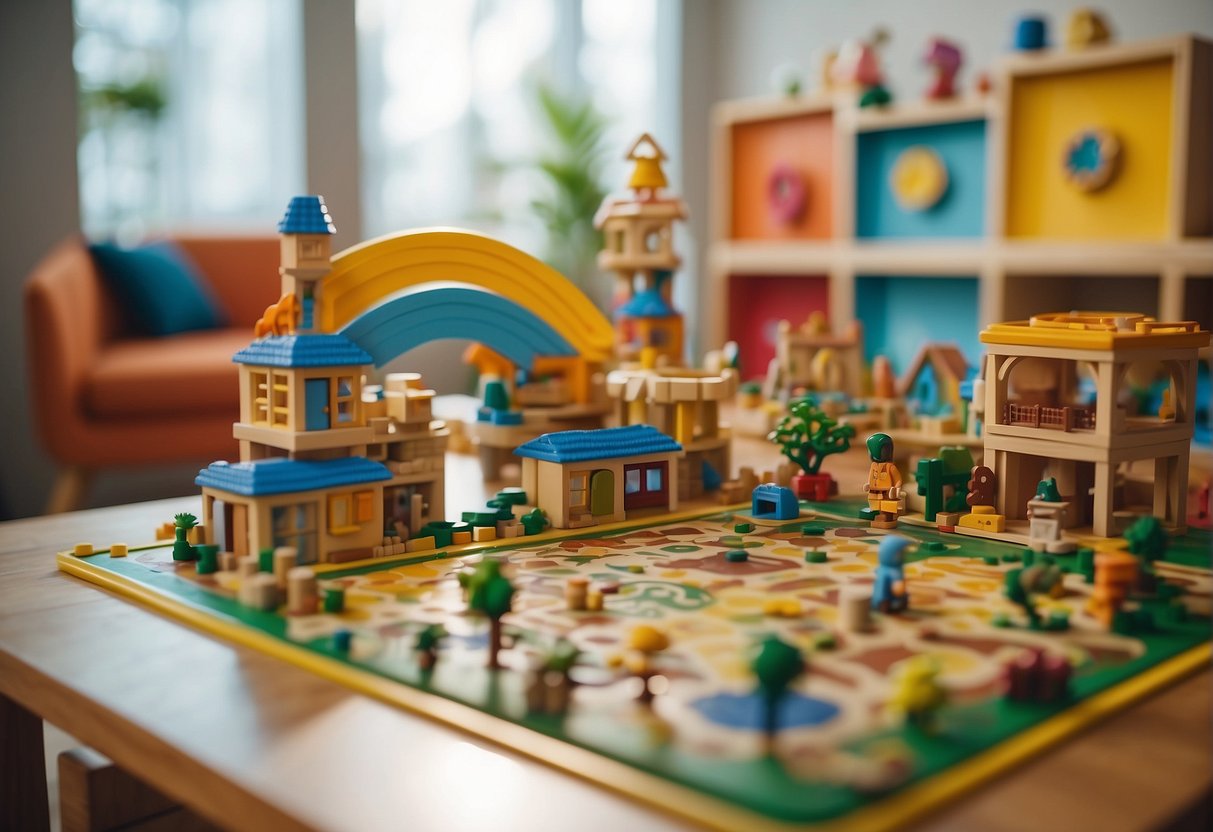Dressing a toddler is an artful balance between functionality and comfort, tailored to a child’s active lifestyle and the whims of weather. The choices parents make in their toddler’s wardrobe can promote independence as children learn to dress themselves and develop personal preferences.
Seasonal changes and growth spurts require a thoughtful approach to selecting appropriate clothing, focusing not just on the aesthetics but also on the safety, durability, and ease of movement.

Materials play a crucial role in a toddler’s comfort and safety. Natural, breathable fabrics like cotton are preferred for their gentleness on sensitive skin and their ability to keep a child cool during active summer days. As sunlight intensifies, protective accessories like wide-brimmed sunhats and UV-blocking sunglasses become essential.
Conversely, in colder months, layering becomes paramount to ensure warmth without sacrificing mobility, starting with a snug base layer and culminating with a water-resistant outer shell.
Beyond the immediate comfort, practicality dictates the need for clothes that are easy to put on and remove, catering to the fast-paced learning environment of a toddler.
Elastic waists, velcro fasteners, and stretchable materials support a child’s growing desire for independence by enabling them to dress with minimal assistance. With the right clothing choices, toddlers can explore, play, and learn with confidence and ease.
Understanding the Basics of Toddler Clothing

When dressing toddlers, prioritizing comfort and fit is essential. They often have sensitive skin, making the quality and material of their clothing important. Natural fabrics like cotton are commonly recommended because they are soft and offer breathability which is ideal for their active lifestyle.
Toddler fashion can balance style with functionality. It is advantageous to choose apparel that supports toddlers as they explore and play. Look for clothes with elastic waistbands, wide neck openings, and easy fasteners that empower toddlers to dress themselves, promoting independence.
| Size | Weight | Height |
|---|---|---|
| 2T | 25-27lb | 32-34in |
| 3T | 28-32lb | 35-37in |
| 4T | 33-36lb | 38-40in |
| 5T | 37-42lb | 41-43in |
These sizes are general guidelines; however, trying on clothes or checking size charts from specific brands can ensure a better fit, as sizing may vary.
Dressing toddlers necessitates a delicate balancing act between ensuring they look agreeable and guaranteeing they’re prepared for the day’s activities. Breathable fabrics that are kind to toddler skin and can withstand the rigors of play are recommended.
Opting for durable, easy-to-clean materials will also simplify maintenance while keeping toddlers neatly dressed.
Factors to Consider When Choosing Clothes

When selecting clothes for a toddler, it’s crucial to weigh various factors such as weather appropriateness, proper fit, and comfort. These considerations ensure that the child is both happy and safe.
Seasonal Considerations
Season greatly influences clothing choices. In summer, opt for breathable fabrics like cotton to keep toddlers cool, while winter demands layering with a base layer and an outer layer. Fleece or wool can provide warmth, but remember to incorporate layers for easy temperature adjustment.
Sizing and Fit
Accurate sizing is fundamental. Use a size chart to match clothing sizes with a child’s height and weight. Keep in mind toddlers’ rapid growth rate and check the chest, waist, and inseam measurements to ensure a proper fit.
Comfort and Safety Features
Select clothes with soft fabrics, elastic waistbands, and well-finished seams to prevent irritation. Avoid non-scratchy tags and choking hazards like loose buttons. Clothes should be safe and comfortable, with easy-to-use snaps or zippers for added safety.
Ease of Dressing and Independence
It’s important for toddlers to learn independence with clothes that they can manage, which also supports fine motor skills. Features like elastic waists and Velcro can aid in self-dressing, especially during potty training.
Fabric Type and Care
Choose durable and easy to clean fabrics, Considering the tendency for frequent messes. Breathable materials are essential, and consider the care instructions — some may require cold water or hand washing. Avoid fabric softeners that may reduce the fabric’s breathability.
Practical Considerations
A toddler’s wardrobe should be both practical and cost-effective. Shop for clothes during sales, at consignment stores, or through online retailers such as Amazon and Walmart. Department stores can also offer a range of options that fit your budget.
Longevity and Size Adjustments
To accommodate quick growth, look for clothes with adjustable features or buy larger sizes. Accessories like belts can help adjust sizing and increase the longevity of garments as the child grows, ensuring a better return on investment.
Building a Versatile Toddler Wardrobe

Creating a versatile toddler wardrobe requires a strategic selection of clothes that are comfortable, durable, and adaptable to different occasions and seasons. Careful consideration ensures parents can dress their toddlers appropriately without frequent shopping trips.
Essential Items
For the foundation of a toddler’s wardrobe, multiple short and long-sleeved t-shirts in soft fabrics such as cotton should be available.
Parents should stock up on several pairs of jeans and leggings, along with comfortable skirts that allow for easy movement. Dresses are practical and can be worn across different settings.
Layering Pieces
Layering is key for adapting to changing temperatures. A typical wardrobe should include a variety of jackets in different weights. Items like sweaters and cardigans offer flexibility and warmth as mid-layers, while a durable outer layer, such as a water-resistant jacket, provides protection against harsh conditions.
Specialty Clothing
Swimwear is necessary for the summer months and any water-related activities. Depending on interests, a selection of costumes and sportswear should be incorporated for play and specific sports or activities. These garments are typically designed for the activity in question, offering both comfort and function.
Accessories and Shoes
A toddler’s wardrobe should feature a range of shoes for different purposes, including sturdy sneakers, rain boots, and sandals. Socks, hats, and belts play functional and aesthetic roles. While toddlers generally do not need jewelry, simple, safe pieces could be included for special occasions.
Seasonal Updates
For winter, must-have items include heavy coats and warm hats and gloves. During summer, the focus shifts to sun hats with wide brims and lightweight clothes that protect from UV rays. In spring and fall, adaptable garments like light jackets and rain gear are essential, catering to the fluctuating weather.
Dressing Strategies for Toddlers

Dressing toddlers requires a balance of promoting independence while ensuring comfort and safety. This section provides strategies for caregivers to tackle dressing routines effectively.
Encouraging Self-Dressing
Encouraging a toddler to dress themselves fosters independence and cognitive skills. Begin by offering limited choices to reduce overwhelm. For instance, ask them to choose between two shirts. Simplify the process by using clothes with large buttons or Velcro closures to enhance their fine motor skills. Always make it fun; turn dressing into a game to maintain their interest.
Managing Dressing Challenges
To mitigate frustration, keep a consistent routine and be patient. Encountering difficulties is normal as toddlers develop fine motor skills. If a child becomes sensitive or upset, acknowledge the struggle and offer assistance.
During potty training, facilitate the process with easily removable clothing, reducing potential stress for both the child and caregiver.
Styling and Layering Techniques
Styling should prioritize the child’s comfort and allow for easy movement. Layering is key for adapting to changing temperatures: start with a breathable base, add a warm middle layer, and finish with a protective outer layer.
Choose styles and patterns that reflect the child’s individuality, and remember that accessories can be both fun and functional, like sunhats for protection.
Safety Considerations
When dressing toddlers, safety is paramount. Avoid drawstrings and small, detachable parts that pose choking hazards. For sleepwear, close-fitting clothes reduce the risk of sudden infant death syndrome (SIDS). Always use non-irritating fabrics for sensitive skin and double-check for any loose buttons or broken zippers.
Educational Aspects of Dressing
Dressing offers educational opportunities. Use this time for teaching body parts, colors, and clothing types. Modeling how to dress by breaking down steps can be beneficial.
Reference experts like Heidi Murkoff, who provides insight into the developmental aspects of self-care skills in toddlers, highlighting the importance of nurturing cognitive and fine motor development through daily activities like dressing.
Shopping Tips and Tricks

When it comes to clothing your toddler, shopping smart is key. From finding deals to understanding labels and ensuring safety, this guide equips parents to make informed decisions.
Finding Deals and Sales
Parents can stretch their budget by scouting for sales and discounts at both brick-and-mortar stores and online retailers such as Amazon and Walmart. Consignment stores are also an excellent place to find quality garments at a fraction of the cost, especially since toddlers outgrow clothes quickly.
- Sign up for newsletters from favorite stores to get alerts on upcoming sales.
- Check out clearance racks in the back of department stores.
Understanding Clothing Labels
A garment’s label provides essential information about fabric content and wash instructions. Look for breathable and durable fabrics like cotton for comfort and longevity. Clothing labels also give insight into the quality of the garment.
- 100% cotton is ideal for everyday wear due to its softness and ease of care.
- Layered garments should have washable outer layers to handle stains and dirt with ease.
Navigating Retail Options
Parents have a variety of retail options, from local boutiques to major department stores. Online shopping offers convenience, with websites often grouping clothing by age, making it easier to find size-appropriate attire.
- Use filters to sort by size, price, and customer ratings.
- Consider purchases from websites that allow free returns in case the fit or quality doesn’t meet expectations.
Ensuring Clothing Safety
Safety should be a top priority. Avoid clothing with small buttons or decorations that could pose a choking hazard. Garments should be free from long cords or ties that might injure a toddler during play or napping.
- Select clothes with secure fastenings and soft seams to minimize risks.
- Snaps are preferable to buttons for easy accessibility when helping toddlers get dressed.
Care and Maintenance Tips
Effective care extends the life of children’s clothing. Always adhere to specified wash instructions to prevent clothing from becoming faded or delicate items from being damaged.
- Use stain removers designed for children’s clothing to tackle tough stains without damaging the fabric.
- Consider the durability of clothes and how they will hold up to repeated washing.
Fostering Creativity Through Dress

Dressing toddlers is an opportunity to nurture their creativity and sense of self. By incorporating choice and encouraging playful experimentation with clothing, parents can support their child’s cognitive skills and independence.
Promoting Individuality
Offering a variety of toddler clothes allows children to express their individuality. Parents should provide a wardrobe that includes a range of colors, textures, and patterns, and allow toddlers to choose what they want to wear. This practice not only fosters a sense of style but also encourages decision-making, an important cognitive skill.
Involving Toddlers in Choices
By giving toddlers limited choices in what to wear, you can promote their independence while ensuring they make suitable selections. For example, ask whether they prefer the blue shirt or the red one. This involvement helps build their confidence and cognitive skills as they learn to get dressed on their own.
Mixing Patterns and Colors
Encourage toddlers to mix and match patterns and colors to create unique outfits. This freedom boosts their creativity and self-expression, and can transform the routine of getting dressed into a fun, educational experience.
Emphasizing that there is no ‘wrong’ choice when it comes to personal style supports their developing sense of individuality.
Themed Dressing and Play
Incorporating costumes and themed dress into play is a delightful way for toddlers to explore different roles and scenarios. Whether it’s a superhero cape or a doctor’s coat, role play with costumes heightens their creativity and helps in the development of social and cognitive skills.
Accessories such as hats, jewelry, or sunglasses can add to the fun and offer additional layers of self-expression.
Understanding Growth and Size Changes

Selecting the right clothing for a toddler can be challenging due to their rapid growth and ever-changing sizes. Parents need to consider the child’s growth milestones and the durability and flexibility of clothes to ensure comfort and longevity.
Tracking Growth Milestones
A toddler’s growth rate is a critical factor to monitor when purchasing clothing. They grow an average of 3 inches and gain around 4 to 5 pounds each year. Parents should regularly measure their toddler’s height and weight to compare against standard size charts, ensuring garments purchased are the correct size. A size chart often lists clothing sizes by a toddler’s height, weight, or age, such as:
- 2T: 25–27 lbs., 32–34 in.
- 3T: 28–32 lbs., 35–37 in.
- 4T: 33–36 lbs., 38–40 in.
- 5T: 37–42 lbs., 41–43 in.
Adapting to Rapid Changes
Given that toddlers experience rapid changes in both height and weight, parents should opt for clothing that can adapt to these changes. Features like elastic waists or adjustable straps provide flexibility and ensure clothes fit for longer periods.
Clothing with these adaptable features help accommodate the unpredictable growth spurts of toddlers without the need for frequent wardrobe replacements.
Choosing Durable and Flexible Clothes
Durability and flexibility in toddler clothing are paramount. Parents should look for durable fabrics that can withstand frequent washing, such as stretchy cotton, which is also soft against the toddler’s skin.
Purchasing larger sizes can be a practical choice to extend the wearability of the clothing through several growth spurts. Clothes that are stretchy and have a forgiving fit, like those with ruched or pleated designs, will cater to a growing toddler’s needs and offer longevity through the varied stages of growth.
- 15 Football-Themed Snack Ideas for Kids & Teens - September 9, 2024
- 15 Mistake Quotes For Kids - September 7, 2024
- Fun Shark Quotes and Sayings For Kids - September 7, 2024








